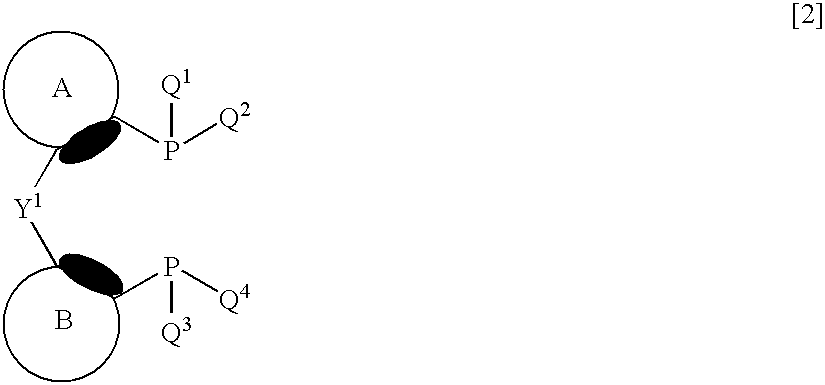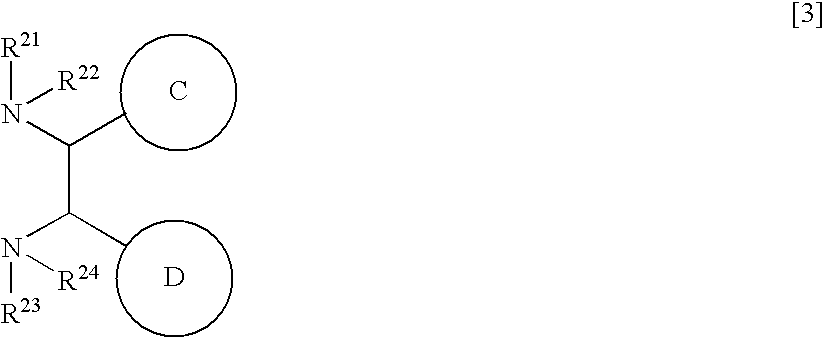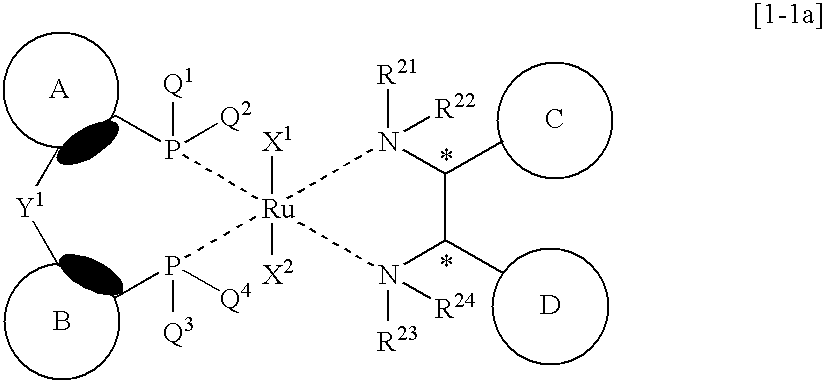Novel transition metal complex and process for producing optically active alcohol
a transition metal complex and optically active technology, applied in the direction of organic compound/hydride/coordination complex catalyst, organic compound/chemical process catalyst, ruthenium organic compound, etc., can solve the problems of asymmetric yield of diphosphine-ruthenium-optically active diamine complex, disadvantageous industrial use of compound, and high cost of axially asymmetric diphosphine ligand compound, etc., to achieve high optical purity, high yield, and high asymmetric yield
- Summary
- Abstract
- Description
- Claims
- Application Information
AI Technical Summary
Benefits of technology
Problems solved by technology
Method used
Image
Examples
example 1
Synthesis of RuCl2{2,2′-bis(diphenylphosphinyl)benzophenone}{(S,S)-DPEN}
(1) Synthesis of 2,2′-bisfluorobenzhydrol
[0253] A mixed solution of 455 μL (4.2 mmol) of 2-bromofluorobenzene and 15 ml of tetrahydrofuran was cooled to −70° C. Thereto was added 2.8 ml (4.4 mmol) of n-butyllithium, and the resultant was stirred for 30 minutes while the temperature thereof was kept at −70° C. Thereafter, thereto was added 165 μL (2.0 mmol) of ethyl formate and the resultant was stirred at room temperature for 15 hours. To the reaction mixture was added 10 mL of water, and then the resultant mixture was extracted with methylene chloride 3 times. The organic phases were collected and washed with water, and then dried over magnesium sulfate. The resultant was concentrated to collect the solvent, and then the concentrate was purified by column chromatography on silica gel (ethyl acetate:hexane=1:5) to give 375 mg (yield: 85%) of the title compound in the form of a yellow solution.
[0254]1H NMR (CDC...
example 2
Synthesis of RuCl2{2-diphenylphosphinobenzhydrol}{(S,S)-DPEN}
(1) Synthesis of 2,2′-bis(trifluoromethanesulfonyloxy)benzophenone
[0264] Into 15 ml of methylene chloride were dissolved 856.9 mg (4.0 mmol) of 2,2′-dihydroxybenzophenone and 97.7 mg (0.8 mmol) of dimethylaminopyridine, and the solution was cooled to 0° C. Thereto was added 1.2 ml (10 mmol) of 2,6-lutidine, and then 1.7 mL (10 mmol) of trifluoromethanesulfonic acid anhydride was added dropwise thereto. Thereafter, the solution was stirred at room temperature for 18 hours. The reaction mixture was washed with water and brine, and then dried over magnesium sulfate. The solvent was distilled off under reduced pressure, and then the resultant was purified by column chromatography on alumina (ethyl acetate:hexane=1:4) to give 1.42 g (yield: 75%) of the title compound in the form of an orange liquid.
[0265]1H NMR (CDCl3) δ ppm; 7.39-7.70 (8H, m).
[0266]19F NMR (CDCl3) δ ppm; −73.75 (s).
(2) Synthesis of 2,2′-bis{diphenylphosphi...
example 3
Synthesis of 2,2′-bis{di-(3,5-xylyl)phosphino}benzophenone
(1) Synthesis of 2,2′-bis(trifluoromethanesulfonyloxy)benzophenone
[0276] Into 15 ml of methylene chloride were dissolved 856.9 mg (4.0 mmol) of 2,2′-dihydroxybenzophenone and 97.7 mg (0.8 mmol) of dimethylaminopyridine, and the solution was cooled to 0° C. After thereto was added 1.2 ml (10 mmol) of 2,6-lutidine, 1.7 ml (10 mmol) of trifluoromethanesulfonic acid anhydride was added dropwise thereto. Thereafter, the solution was stirred at room temperature for 18 hours. The reaction mixture was washed with water and brine, and then dried over magnesium sulfate. The solvent was distilled off under reduced pressure, and then the resultant was purified by column chromatography on alumina (ethyl acetate:hexane=1:4) to give 1.42 g (yield: 75%) of the title compound in the form of an orange liquid.
[0277]1H NMR (CDCl3) δ ppm; 7.39-7.70 (8H, m).
[0278]19F NMR (CDCl3) δ ppm; −73.75 (s).
(2) Synthesis of 2,2′-bis{di-(3,5-xylyl)phosph...
PUM
| Property | Measurement | Unit |
|---|---|---|
| temperature | aaaaa | aaaaa |
| temperature | aaaaa | aaaaa |
| temperature | aaaaa | aaaaa |
Abstract
Description
Claims
Application Information
 Login to View More
Login to View More - R&D
- Intellectual Property
- Life Sciences
- Materials
- Tech Scout
- Unparalleled Data Quality
- Higher Quality Content
- 60% Fewer Hallucinations
Browse by: Latest US Patents, China's latest patents, Technical Efficacy Thesaurus, Application Domain, Technology Topic, Popular Technical Reports.
© 2025 PatSnap. All rights reserved.Legal|Privacy policy|Modern Slavery Act Transparency Statement|Sitemap|About US| Contact US: help@patsnap.com



